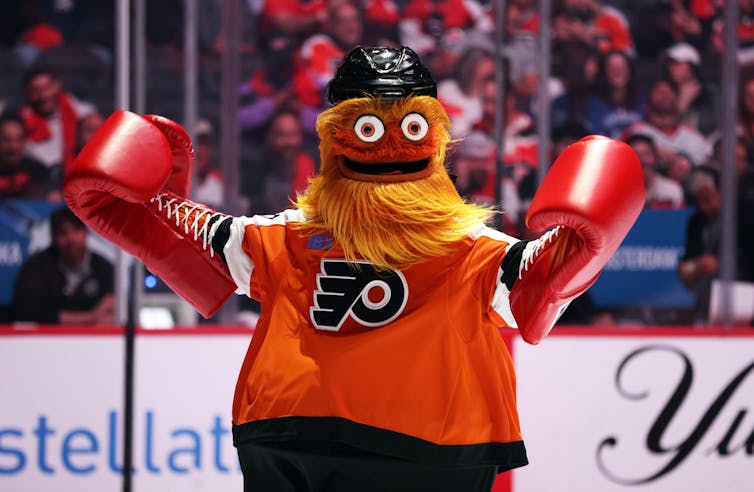Philadelphia sports fans like to think of themselves as "gritty."
In Philadelphia, grit can be defined as a working-class ideology that thrives on “underdog” identity, emphasizing toughness, hard work, physical fitness, and a combative spirit of defiance.
The tenacity of Philadelphia sports fans was best demonstrated when Eagles fans threw snowballs at Santa Claus at Franklin Field on December 15, 1968.
More than 50,000 Eagles fans showed up on that cold December day to support their team, which was 2-11 on the season, in the final game of the season. A Christmas pageant was scheduled for halftime, but Santa never showed up. A staff member trying to save the pageant spotted a diminutive fan in the stands, Frank Olivo, wearing a second-hand Santa suit. Frank was chosen as a substitute at the last minute. When the imperfect Santa Claus walked across the field and tried to greet the crowd, fans were not in the mood given the team's record.
The rest is history.
As sports writers and news outlets amplified and resurrected the Santa Claus story over and over again, it cemented a storyline that painted Philadelphia sports fans as mean-spirited and hostile—the worst of the worst. things.
But Philadelphia sports fans’ passion for their teams is about more than just noise and brutality.
I am dean of the College of Arts and Humanities and professor of communication at Eastern University in suburban Philadelphia. My colleague Ellen Santa Maria, an adjunct lecturer in the Department of Communication Studies at West Chester University, and I recently took a closer look at the resilient identities of Philadelphia sports fans.
We argue that this identity based on fact and fiction not only explains the passion of Philadelphia sports fans but also emphasizes the power of myth in contemporary society.

Myths in American Culture
Myths are storylines driven by memory and imagination that represent oversimplifications of events, characters, and relationships.
The content of myth is more emotional than logical, combining reality and fiction. Myths also convey values and beliefs accepted by individuals and groups, which influence their actions and behaviors.
Cultures create myths to convey morals, reaffirm beliefs, and justify actions. Examples of American cultural myths include, but are not limited to, American exceptionalism, the American frontier, the rugged individual, and the American dream.
Because myths are based on belief, mere mention of an event or situation confirms the myth, while contrary information can easily be ignored, downplayed, or rationalized away. For example, rugged individualism emphasizes the idea that the self-made person can succeed independently. However, this myth ignores or downplays the fact that most people who achieve success have significant social, financial, or political support.
Philadelphia’s “Tough” Fans
Where does Philadelphia’s gritty identity come from? One common explanation is that it arose as early as 1800, when Philadelphia lost its status as the nation's capital and moved to Washington, DC. As a result, Philadelphians began to view their city as a failure.
Today, Philadelphia sports fans expect local teams and players to display working-class ideology in their playing styles. Philly likes players who are tenacious, hard-working, and give it their all every game.
Philadelphia sports history is filled with examples of perseverance.
For example, the Phillies and Eagles played at Veterans Stadium for decades until it was demolished in 2004, and the stadium was known for housing a jail in the basement for unruly fans.
The Flyers hockey team became known as the "Broad Street Bullies" in the 1970s as they won the Stanley Cup for their aggressive, physical style of play.
An infamous game between the Eagles and the Washington Redskins in 1990 is popularly known as the "body bag game." Six Washington players missed the game due to injuries. An Eagles player reportedly told the Washington bench at one point, "Do you still need body bags?" In fact, none of the injuries were fatal.
In 2010, a Phillies fan was beaten by Philadelphia police for running onto the field. Footage of the fan dodging security before collapsing further reinforced Philadelphia's reputation as unruly and obnoxious fans.
[embed]https://www.youtube.com/watch?v=Uy3CIFjwgBM[/embed]
In 2018, the Flyers debuted their new mascot - a tall, pot-bellied orange monster with a beard and googly eyes named "Gritty."
Rocky: The icon of perseverance
But no character was more influential in cementing Philadelphia's gritty identity than fictional boxer Rocky Balboa in the 1976 cult classic "Rocky," written by Sylvester Stallone and starring.
Rocky was a working-class Italian-American boxer from South Philly who rose from a small-club boxer and loan shark enforcer to eventually becoming the heavyweight champion of the world.
"Rocky" embodies the definition of myth because the film combines reality and fiction. The character was filmed at real locations in Philadelphia, including the Italian Market, Independence Hall, Pat's Steak King, and the Philadelphia Museum of Art. This lends authenticity to the characters, but a rags-to-riches storyline, while emotionally satisfying, is unlikely.

Philadelphia loves the character so much that it now hosts "Rocky Days," "Rocky Days" and "Rocky Run" every year. The Philadelphia Museum of Art, despite its world-renowned art collection, may be better known for its "Rocky Steps" and the outdoor "Rocky" statue that visitors line up to take photos of.
So when the next "gritty" incident makes Philly sports headlines, those who think Philly fans are rude and obnoxious will likely point to it as further evidence, while Philly sports fans will dismiss or rationalize that characterization as It's a misunderstanding of them. enthusiasm.